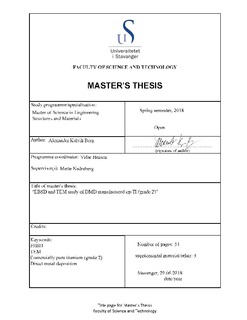| dc.contributor.advisor | Hansen, Vidar Folke | |
| dc.contributor.author | Berg, Alexander | |
| dc.date.accessioned | 2018-09-11T09:08:58Z | |
| dc.date.available | 2018-09-11T09:08:58Z | |
| dc.date.issued | 2018-06-29 | |
| dc.identifier.uri | http://hdl.handle.net/11250/2561937 | |
| dc.description | Master's thesis in Mechanical engineering | nb_NO |
| dc.description.abstract | Two components, 3D printed by Norsk Titanium components, through a direct metal deposition plasma transferred arc. An additive layer manufacturing technique. One made of a single wire layer thin sample, and one made of two wires thick sample. These components were to be studied through transmission electron microscope (TEM) and through the use of electron backscattering diffraction (EBSD) detector. Electrochemical polishing was used for etchant, to avoid using hydrofluoric acid because of its volatile nature. During the thesis it was also a point to see what kind of deformations the electrochemical polishing would uncover. During the TEM study it was found that the components a dislocation density in the order of 109cm-2. The flow stress was calculated to be average 298MPa because of the dislocation density. The ratio of the different dislocation types was measured and calculated in TEM through a technique called weak beam together with g·b=0 criterion. The density of pure edge was found to be 1,84*〖10〗^9 cm^(-2) in an area which contained 3,19*〖10〗^9 cm^(-2). Leading to a higher density of pure edge dislocation compared to mix and screw dislocation. Strain energy for edge dislocation is about 50% higher than screw, which leads to higher strain energy for the area. The stress field for edge dislocation is increased by the same amount. Through the TEM in a complete α-phase areas, elongated β structures were found. Through the use of the EBSD, the two wire component with a non-machined inside were studied. Small fraction of β-phase on the inside of the component was discovered. This is the area exposed to the argon atmosphere during manufacturing. For β-phase to be retained, the cooling rate must have been sufficiently high. Above a critical point of 15℃/s. The middle and outside of the component had no detectable β-phase. Meaning that the cooling rate is higher where it was exposed to argon gas. This could mean that heat dissipation is not high enough in the metal to form retained β-phase and the heat dissipates more quickly to gaseous environment. Tensile twinning were discovered matching {101 ̅2}<1 ̅011>. These twinning deformations were observed through the sample. In the two wire made component, increased twinning were observed in the middle of the horizontal plane (XY) and could be the area of the two wires overlapping. The misdirection angles showed peaks of 60° and 90° corresponding to the misorientation planes of the phase transformation of <110>β to hcp which is either 60° or 90°. Comparing the vertical and the horizontal plane of the thin sample made of one wire. Elongated grains were seen in the vertical plane corresponding to columnar grains in the epitaxial growth direction. The misorientation angles peaked at 60° corresponding to the <110>β plane transformation which favors the 60°. | nb_NO |
| dc.language.iso | eng | nb_NO |
| dc.publisher | University of Stavanger, Norway | nb_NO |
| dc.relation.ispartofseries | Masteroppgave/UIS-TN-IMBM/2018; | |
| dc.rights | Navngivelse-Ikkekommersiell 4.0 Internasjonal | * |
| dc.rights.uri | http://creativecommons.org/licenses/by-nc/4.0/deed.no | * |
| dc.subject | maskinteknikk | nb_NO |
| dc.subject | titanium | nb_NO |
| dc.title | EBSD and TEM study of DMD manufactured cp-TI (grade 2) | nb_NO |
| dc.type | Master thesis | nb_NO |
| dc.subject.nsi | VDP::Teknologi: 500::Maskinfag: 570::Maskinkonstruksjon og materialteknologi: 571 | nb_NO |

